stop start PONTIAC GRAND-AM 1995 Owners Manual
[x] Cancel search | Manufacturer: PONTIAC, Model Year: 1995, Model line: GRAND-AM, Model: PONTIAC GRAND-AM 1995Pages: 354, PDF Size: 17.81 MB
Page 66 of 354

New Vehicle “Break-In” Ignition Switch
NOTICE:
Your modern Pontiac doesn’t need an elaborate
“break-in.” But
it will perform better in the long
run if you follow these guidelines:
0
0
0
Don’t drive at any one.speed -- fast or
slow
-- for the first 500 miles (804 km).
Don’t make full-throttle starts.
Avoid making hard stops for the first 200
miles (322 km) or so. During this time your
new brake linings aren’t yet broken in.
Hard stops with new linings can mean
premature wear and earlier replacement.
Follow this “breaking-in’’ guideline every
time
you get new brake linings.
Don’t tow
a trailer during “break-in.” See
“Towing
a Trailer” in the Index for more
information.
A E
W
With the key in the ignition switch, you can turn the
switch to five positions:
ACCESSORY (A): This is an “on” position in which
you can operate some
of your electrical power
accessories. Press
in the ignition switch as you turn the
top
of it toward you.
2-11
ProCarManuals.com
Page 68 of 354
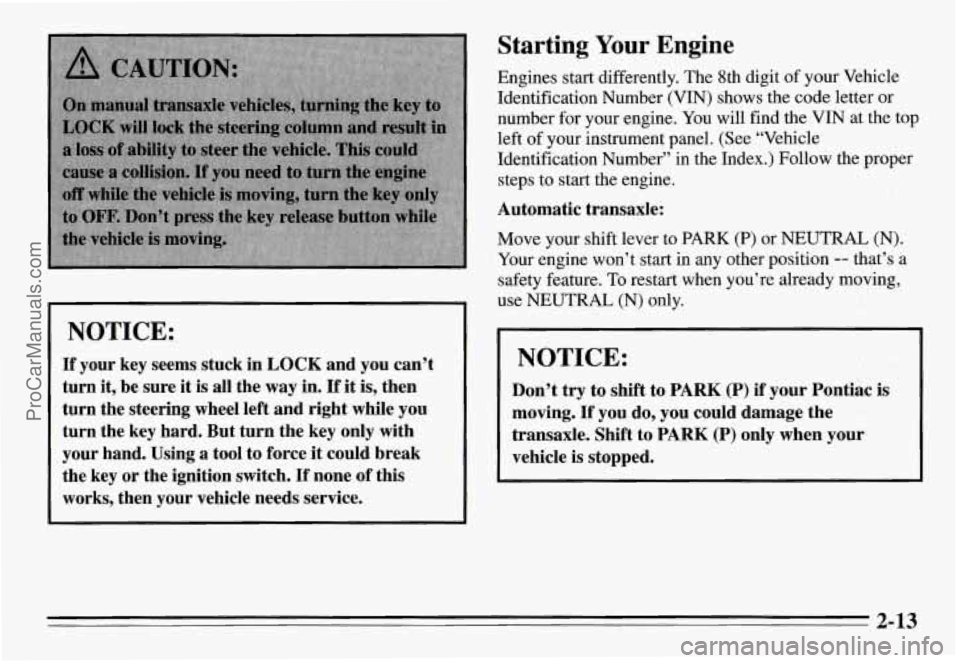
I NOTICE:
If your key seems stuck in LOCK and you can’t
turn it, be sure it is all the
way in. If it is, then
turn the steering wheel left and right while you
turn the key hard. But turn the key only with
your hand. Using
a tool to force it could break
the key or the ignition switch.
If none of this
works, then your vehicle needs service.
Starting Your Engine
Engines start differently. The 8th digit of your Vehicle
Identification Number (VIN) shows the code letter or
number for your engine.
You will find the VIN at the top
left of your instrument panel. (See “Vehicle
Identification Number” in the Index.) Follow the proper
steps to start the engine.
Automatic transaxle:
Move your shift lever to PARK (P) or NEUTRAL (N).
Your engine won’t start in any other position
-- that’s a
safety feature.
To restart when you’re already moving,
use NEUTRAL (N) only.
NOTICE:
Don’t try to shift to PARK (P) if your Pontiac is
moving. If you do, you could damage the
transaxle. Shift to PARK
(P) only when your
vehicle
is stopped.
2-13
ProCarManuals.com
Page 69 of 354
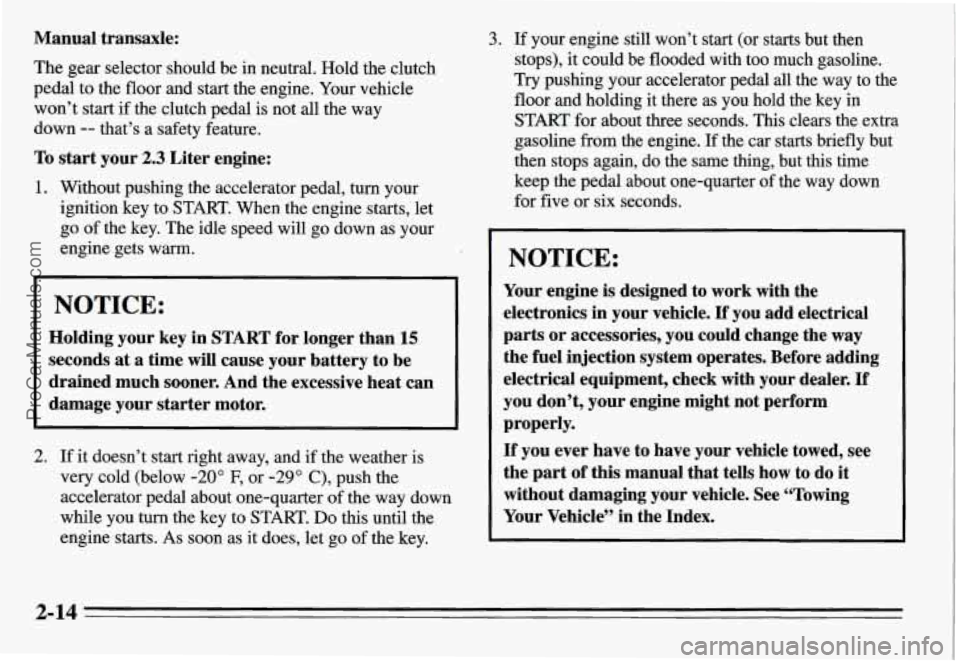
Manual transaxle:
The gear selector should be in neutral. Hold the clutch
pedal to the floor and
start the engine. Your vehicle
won’t start
if the clutch pedal is not all the way
down
-- that’s a safety feature.
To start your 2.3 Liter engine:
1. Without pushing the accelerator pedal, turn your
ignition key to START. When the engine starts, let
go of the key. The idle speed will go down as your
engine gets warm.
NOTICE:
Holding your key in START for longer than 15
seconds at a time will cause your battery to be
drained much sooner. And the excessive heat can
damage your starter motor.
I
2. If it doesn’t start right away, and if the weather is
very cold (below
-20” F, or -29” C), push the
accelerator pedal about one-quarter of the way down
while you turn the key to START.
Do this until the
engine starts. As soon as it does, let
go of the key.
3. If your engine still won’t start (or starts but then
stops), it could be flooded with too much gasoline.
Try pushing your accelerator pedal
all the way to the
floor and holding it there as you hold the key in
START for about three seconds.
This clears the extra
gasoline from the engine. If the car starts briefly but
then stops again, do the same thing, but this time
keep the pedal about one-quarter of
the way down
for five or six seconds.
NOTICE:
Your engine is designed to work with the
electronics in your vehicle.
If you add electrical
parts or accessories, you could change the
way
the fuel injection system operates. Before adding
electrical equipment, check with your dealer.
If
you don’t, your engine might not perform
properly.
If you ever have to have your vehicle towed, see
the part
of this manual that tells how to do it
without damaging your vehicle. See “Towing
Your Vehicle’’ in the Index.
2-14
ProCarManuals.com
Page 70 of 354
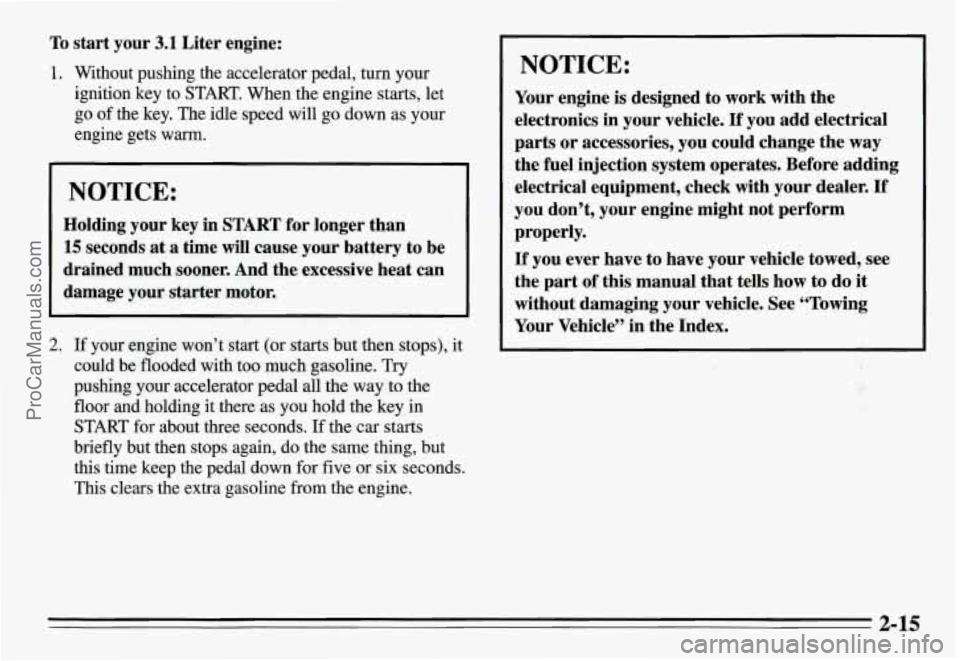
To start your 3.1 Liter engine:
1. Without pushing the accelerator pedal, turn your
ignition key to START. When the engine starts, let
go
of the key. The idle speed will go down as your
engine gets warm.
NOTICE:
Holding your key in START for longer than
15 seconds at a time will cause your battery to be
drained much sooner. And the excessive heat can
damage your starter motor.
2. If your engine won’t start (or starts but then stops), it
could be flooded with
too much gasoline. Try
pushing your accelerator pedal all the way to the
floor and holding
it there as you hold the key in
START for about three seconds.
If the car starts
briefly but then stops again, do the same thing, but
this time keep the pedal down for five or six seconds.
This clears the extra gasoline from the engine.
NOTICE:
Your engine is designed to work with the
electronics in your vehicle.
If you add electrical
parts or accessories, you could change the way
the fuel injection system operates. Before adding
electrical equipment, check with your dealer.
If
you don’t, your engine might not perform
properly.
If you ever have to have your vehicle towed, see
the part of this manual that tells how to do
it
without damaging your vehicle. See “Towing
Your Vehicle” in the Index.
2-15
ProCarManuals.com
Page 74 of 354
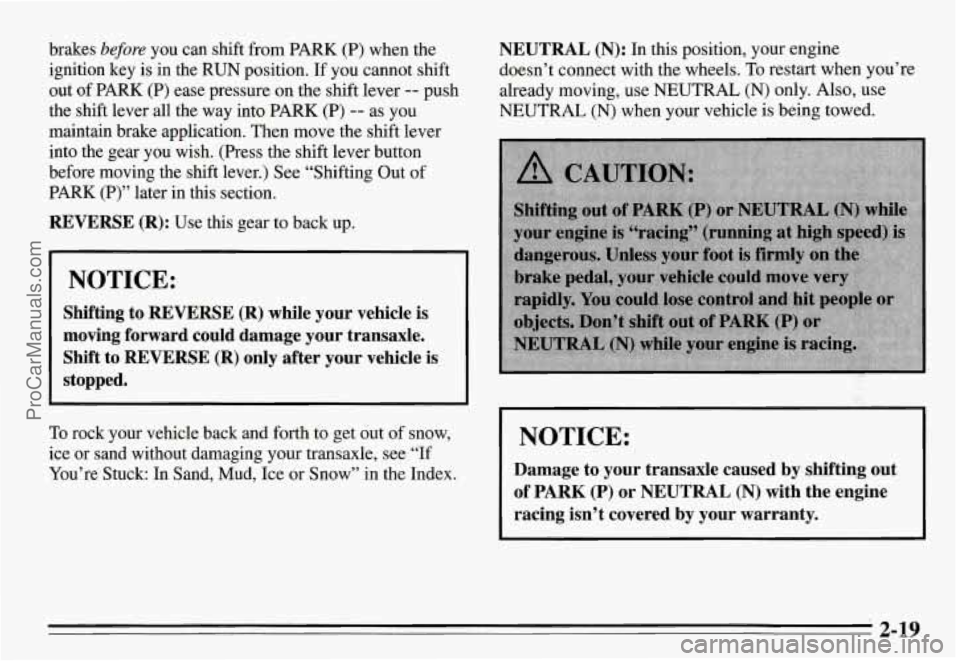
brakes before you can shift from PARK (P) when the
ignition key is in the
RUN position. If you cannot shift
out of PARK (P) ease pressure on the shift lever
-- push
the shift lever all the way into PARK
(P) -- as you
maintain brake application. Then move the shift lever
into the gear you wish. (Press the
shift lever button
before moving the shift lever.) See “Shifting Out of
PARK (P)” later in this section.
REVERSE (R): Use this gear to back up.
NOTICE:
Shifting to REVERSE (R) while your vehicle is
moving forward could damage your transaxle.
Shift to REVERSE
(R) only after your vehicle is
stopped.
To rock your vehicle back and forth to get out of snow,
ice or sand without damaging your transaxle, see “If
You’re Stuck: In Sand, Mud, Ice
or Snow” in the Index.
NEUTRAL (N): In this position, your engine
doesn’t connect with the wheels.
To restart when you’re
already moving, use NEUTRAL
(N) only. Also, use
NEUTRAL
(N) when your vehicle is being towed.
I NOTICE: I
Damage to your transaxle caused by shifting out
of
PARK (P) or NEUTRAL (N) with the engine
racing isn’t covered by your warranty.
2-19
ProCarManuals.com
Page 78 of 354

THIRD, FOURTH and FIFTH (3,4 and 5): Shift into
THIRD (3), FOURTH (4) and l?lFTH (5) the same way
you do for
SECOND (2). Slowly let up on the clutch
pedal as you press the accelerator pedal.
To Stop: Let up on the accelerator pedal and press the
brake pedal.
Just before the vehicle stops, press the
clutch pedal and the brake pedal, and shift into
NEUTRAL
(N).
NEUTRAL (N): Use this position when you start or
idle your engine.
REVERSE (R): To back up, press down the clutch
pedal and shift into REVERSE
(R) Let up on the clutch
pedal slowly while pressing the accelerator pedal.
I NOTICE:
Shift to REVERSE (R) only after your vehicle is
stopped. Shifting to REVERSE (R) while your
vehicle is moving could damage your transaxle.
Also, use REVERSE (R), along with the parking brake,
for parking your vehicle.
Shift Light
0
SHIFT
If you have a manual
transaxle, you have a
SHIFT light. This light will
show
you when to shift to
the next higher gear for best
fuel economy.
k' . :I
When this light comes on, you can shift to the next
higher gear if weather, road and traffic conditions let
you. For the best fuel economy, accelerate slowly
and
shift when the light comes on.
While you accelerate, it is normal for the light to go on
and
off if you quickly change the position of the
accelerator. Ignore the
SHIFT light when you downshift.
Shift Speeds (Manual Transaxle)
This chart shows when to shift to the next higher gear
for best fuel economy.
2-23
ProCarManuals.com
Page 116 of 354
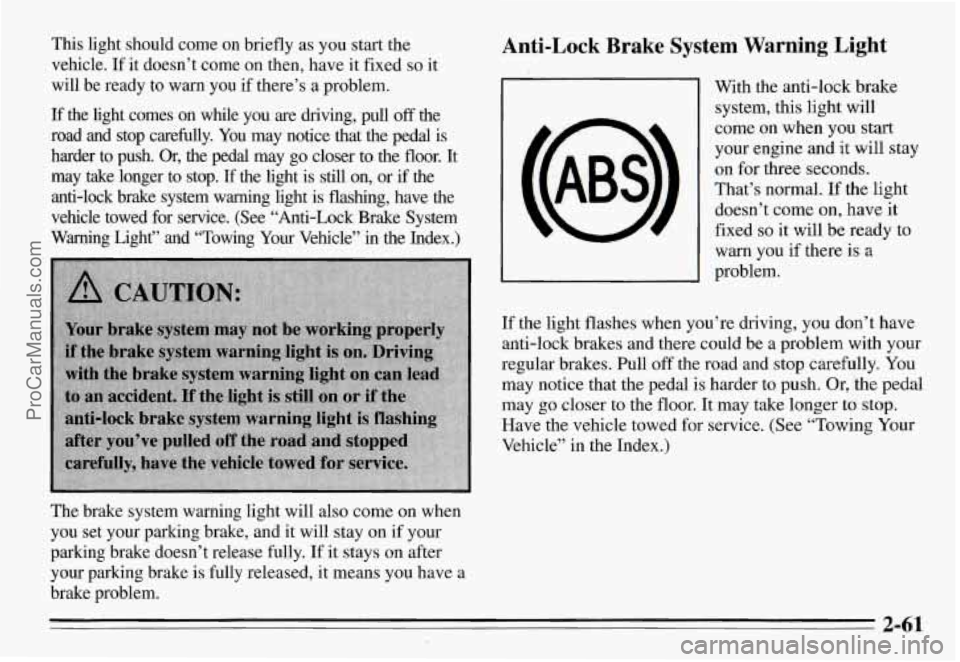
This light should come on briefly as you start the
vehicle. If it doesn’t come on then, have it fixed
so it
will be ready to warn you if there’s a problem.
If the light comes on while you are driving, pull off the
road
and stop carefully. You may notice that the pedal is
harder to push.
Or, the pedal may go closer to the floor. It
may take longer to stop. If the light is still on, or if the
anti-lock brake system warning light is flashing, have the
vehicle towed for service. (See “Anti-Lock Brake System
Warning Light” and “Towing Your Vehicle” in the Index.)
The brake system warning light will also come on when
you set your parking brake, and it will stay
on if your
parking brake doesn’t release fully. If it stays on after
your parking brake is fully released, it means you have a
brake problem.
Anti-Lock Brake System Warning Light
1
With the anti-lock brake
svstem. this lirrht will
8 u
come on when you start
your engine and it will stay
on for three seconds.
That’s normal. If the light
doesn’t come
on, have it
fixed
so it will be ready to
warn you if there is a
problem.
If the light flashes when you’re driving, you don’t have
anti-lock brakes and there could be a problem w-ith your
regular brakes. Pull off the road and stop carefully. You
may notice that the pedal is harder to push.
Or, the pedal
may go closer to the floor. It may take longer to stop.
Have the vehicle towed for service. (See “Towing Your
Vehicle” in the Index.)
2-61
ProCarManuals.com
Page 117 of 354
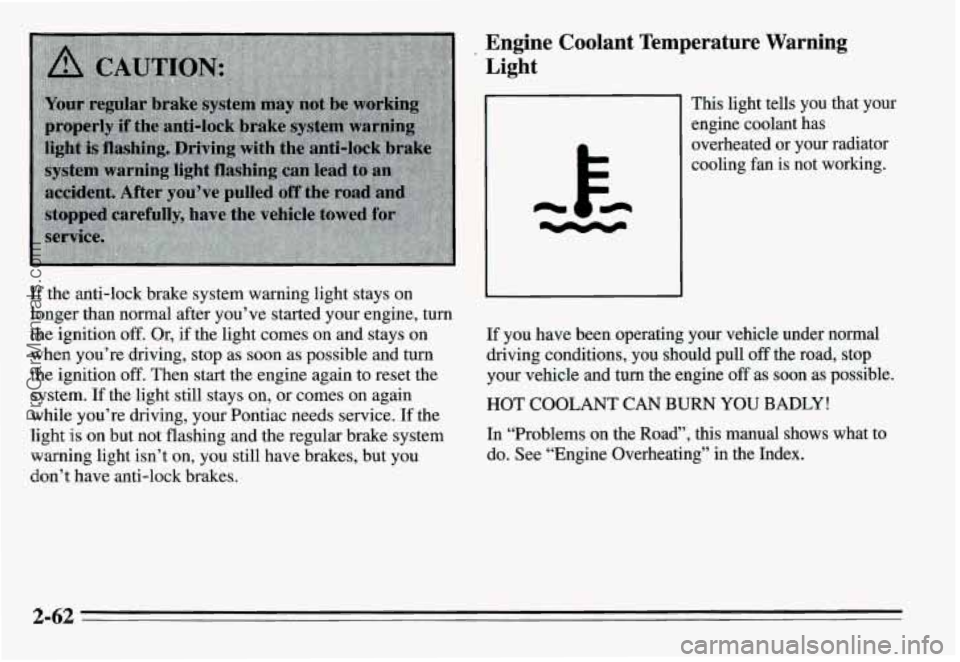
If the anti-lock brake system warning light stays on
longer than normal after you’ve started your engine, turn
the ignition off. Or, if the light comes on
and stays on
when you’re driving, stop as soon as possible and turn
the ignition
off. Then start the engine again to reset the
system. If the light still stays on, or comes on again
while you’re driving, your Pontiac needs service.
If the
light
is on but not flashing and the regular brake system
warning light isn’t on, you still have brakes, but you
don’t have anti-lock brakes.
. Engine Coolant Temperature Warning
Light
This light tells you that your
engine coolant has
overheated or your radiator
cooling fan is not working.
If you have been operating your vehicle under normal
driving conditions, you should pull off the road, stop
your vehicle and turn the engine
off as soon as possible.
HOT COOLANT CAN BURN YOU BADLY!
In “Problems on the Road”, this manual shows what to
do. See “Engine Overheating” in the Index.
2-62
ProCarManuals.com
Page 120 of 354

Oil Warning Light
If you have a problem with your oil, this light may
stay on after you start your
engine, or come on when
you
are driving. This
indicates that oil is not
going through your engine
quickly enough to keep it
lubricated.
The engine could be low on oil, or could have some
other oil problem. Have it fixed right away.
The oil light could
also come on in three other
situations:
When the ignition is on but the engine is not running,
the light will come on as a test to show you it is
working, but the light
will go out when you turn the
ignition
to START. If it doesn’t come on with the
ignition on, you may have a problem with the fuse or
bulb. Have it fixed right away.
0 Sometimes when the engine is idling at a stop, the
0 If you make a hard stop, the light may come on for a
light may blink on and off. This is normal.
moment. This is normal.
NOTICE:
Damage to your engine from neglected oil
problems can be costly and is not covered by your
warranty.
2-65
ProCarManuals.com
Page 138 of 354

The player may be too hot, too cold or the road may
be too rough for the disc to play. As soon as things
get back to normal, the disc should play.
While a disc is playing, the CD indicator is displayed on
the digital display, as is the clock.
RCL: Press this button once to see what track is
playing. Press again within five seconds to see how long
that track has been playing. The track number also will
be displayed when the volume is changed or a new track
starts to play.
COMP: Pressing this button makes soft and loud
passages more equal in volume. Press again to resume
normal play.
RDM: Press to play tracks in random, rather then
sequential, order. Press the button again to play the
tracks sequentially.
REV: Press and hold to reverse the disc rapidly. Release
to resume playing. The counter reading will illuminate
in the graphic display.
FWD: Press and hold to advance the disc rapidly.
Release to resume playing. The counter reading will
illuminate in the graphic display.
PREV: Press to play a track again. If you keep pressing
the
PREV button, the disc will keep backing up to
previous tracks.
NEXT: Press when you want to hear the next track. If
you keep pressing the
NEXT button, the disc will keep
advancing to other tracks.
When Finished with the Compact Disc Player
If you press PWR or turn off the ignition, the disc will
stay in the player and start again when you turn on the
ignition or the PWR button. The disc will begin playing
at the point where it had been stopped.
ST-PL: Press to stop the disc player; the radio will play.
Press again to play the disc (the player will start playing
the disc where it had stopped earlier).
EJCT Press to eject the disc; the radio will play. You
can also eject the disc with the radio
or ignition off.
NOTE: As a safety feature, if the CD is left partway out
of the slot, as when ejected, and the radio
or ignition is
turned
off, the disc will be pulled back into the player.
This will occur in thirty seconds. When the player is
turned back on, the disc will start at track one.
3-15
ProCarManuals.com